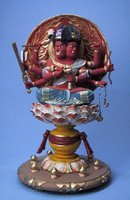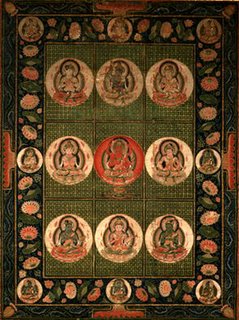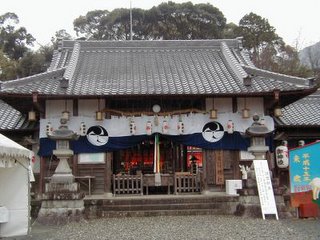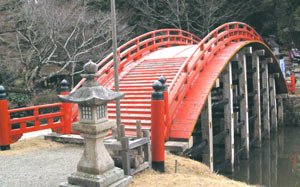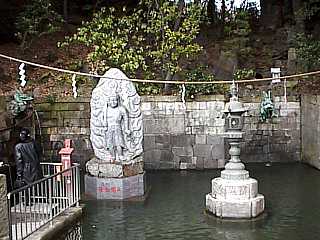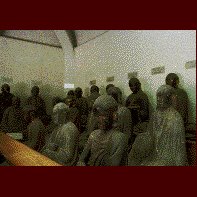:::::::::::::::::::::::::::::::::::::::::::::::::::::::::::::::::::::::::::::::::::::::::::::::::::::
Miso Jizoo, the Bean Paste Jizo みそ地蔵, ミソ地蔵, 味噌地蔵
There are various samples all over Japan.
The Bean Paste Jizo of 才蔵寺 Temple Saizo-Ji
Hiroshima
広島のみそ地蔵(広島県広島市東山)
There is a temple in Hiroshima, Higashiyama, where people bring a flat pack of miso (bean paste), put it on the head of a seated Jizo statue, say a prayer and then put it on their own head, to cure illness or pray for intelligence, to pass the school and university exams.
In the area here in Hiroshima, this Jizo is more popular than Sugawara Michizane, another deity venerated for passing school exams and promotion of learning.
The statue is in the temple Saizo-Ji, in honor of Kani Saizo, retainer of Fukushima Masanori and his deeds during the war at the beginning of the Edo period.
miso can be short for noomiso, the brain, and miso jizo is a play of sounds.
. Kani Saizō 可児才蔵 Kani Saizo .
Kani Yoshinaga 可児吉長 - - (1554 - 1613)
Read more about Fukushima Masanori in my library
才蔵寺は関が原の合戦で福島正則の武将として活躍した可児才蔵(岐阜出身)を祭っている。

また、正則が徳川家に改易とされたとき、戦いに備え食料を集めたという故事のみそ地蔵がある。この地蔵の顔にみそを乗せて祈願をすると希望校に合格するといわれ受験生に人気の場所である。当地域では菅原道真より人気である。
http://www.c-haus.or.jp/kaidou/010kaitahiroshima.htm
oooooooooooooooooooooooooooooooooooooo


Look at the many packs of miso paste, and one on the head of the statue.
~受験生にミソを込めて…の巻~
2006年1月14日放送
Interview of Dai chan.
来週の土曜日と日曜日は大学入試センター試験!ということで、今週の大ちゃん中継は、受験生応援企画!!受験生リスナーの合格祈願を、大ちゃんが一挙に引き受けました。
今回、大ちゃんがお邪魔したのは、東区東山町の才蔵寺。才蔵寺には、「ミソ地蔵」というお地蔵さんがあります。このミソ地蔵の頭の上に味噌を乗せて合格祈願をすると、願いを叶えてくれると言われています。受験シーズンになると、才蔵寺にはたくさんの受験生たちが合格祈願に訪れるそうです。
カツサンドを食べて「受験に勝つ!」と気合を入れた大ちゃんは、住職の笠継智光さんと一緒に、リスナーのみなさんの合格をミソ地蔵に祈願しました。
There are a few more photos on this link
http://www.1350.jp/manin/daichan/
:::::::::::::::::::::::::::::::::::::::::::::::::::::::::::::::::::::::::::::::::::::::::::::::::::::
The Miso Licking Jizo of the temple Yatadera
矢田寺 :「みそなめ地蔵」
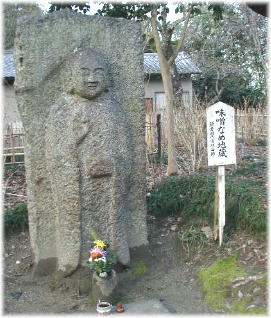
A stone relief of about the size of one tatami.
A farmer's wife had problems with the taste of her home-made miso paste. At night she had a dream, where this Jizo appeared and said: If you past your bad miso on my mouth for me to taste, I will change the taste of it!
As she did so the next morning, the taste of her home-made miso improved greatly.
Now many women come here to smear a bit of miso around the mouth of this Jizo, when they make a new batch of the bean paste every year.
http://www.yatadera.or.jp/cont3-5.html
:::::::::::::::::::::::::::::::::::::::::::::::::::::::::::::::::::::::::::::::::::::::::::::::::::::
Miso Licking Jizo of Yonago
Way in the past, there lived an old priest and his young disciple in Yonago, in the temple Baioo-Ji. They decided to prepare some miso and boiled a large pot of soy beans. When the beans were boiled, the old greedy priest wanted to eat some right away, filled a big bowl with them and retreated to the temple toilet, a smelly place, to eat them in peace, because he thought nobody would detect him there.
The little disciple had the same idea, filled his bowl with beans and headed for the toilet, only to find it occupied by his head priest. The young one's face turned all red, since he felt discovered by his boss, and in a clever movement, streched his arms with the bowl toward the priest and said: "Here, Master, I brought you another bowl to taste."
To that day, it is custom when you have a wish granted, to go to the Jizo statue at this temple and smear some miso around his mouth. During the annual Bon festival, miso is also spread for this Jizo. On the 24th of August, the day of the "Jizo Bon (Jizoo Bon 地蔵盆", there is a large festival in honor of this Miso Jizo.
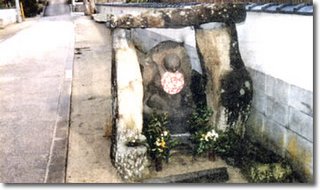
梅翁寺参堂にある「みそなめ地蔵」
http://www.yonago-city.jp/minwa/minwa070.htm
:::::::::::::::::::::::::::::::::::::::::::::::::::::::::::::::::::::::::::::::::::::::::::::::::::::
While looking for material about the Miso Jizo, I found a page about the relation of
Miso and Budda Statues.
The habit of spreading miso sauce around the head and especially the mouth, to have a "Licking Jizo" is found in some other places.
仏様に味噌を塗る!?
そんな失礼な事できません。と思わないで下さい。日本各地には味噌を塗る事によって願い事を叶えてくれる仏様がいるのです。このような事からも”お味噌は、やはり日本人には欠かせないもの”と実感できるのでは、ないでしょうか?お近くの方は、一度お参りに行ってみては、いかがですか?
●広島のみそ地蔵(広島県広島市東山)
才蔵地蔵に味噌を供え、また頭にみそを乗せて供養すると、智恵がついて秀才になり、進学・就職にご利益があるとされている。
Miso Jizo of Hiroshima
●甲府のみそなめ地蔵(甲府市太田町)
稲久山一蓮寺が、一七一三年(正徳三年)に建立したものである。河内道村という僧が西国巡礼の途中でこの寺に寄ったが病臥し、ある夜、夢枕に童児が現れ”味噌を珍重すべし”とお告げがあった。地蔵像一基を建立し味噌を献じて報恩の誠を捧げたところ、霊顕たちどころに現れ、僧の病は日を追って快癒した、というのです。後世の人たちは、この地蔵に味噌を供えて病気平癒・無事息災を祈願してきた。さらに、いつしか、自分の病の部分を託して地蔵の頭や手足に味噌を塗って祈る風習が現れ、みそ舐め地蔵と呼ばれるようになった。
Licking Miso Jizo of Koofu
●蕨のみそぬり目疾(や)み地蔵(埼玉県蕨市)
市役所の近くの三学院の境内には目疾み地蔵があり、目の病気にかかったら、この地蔵に味噌を塗って祈願すれば治るといわれている。
Spreading miso for eye diseases and Jizo
●沼田のみそなめ地蔵(群馬県沼田市)
市内の天桂寺には、三百年の昔からあるという地蔵がある。からだの痛いところと同じ場所に味噌を塗ると、どんな痛みでも取り除くといわれ、口のまわりから頭、足先まで、味噌だらけである。
味噌なめ地蔵(味噌なめ爺さん・味噌なめ婆さん)
Licking Miso Jizo (Grandpa and Grandma)
Temple Tenkei-Ji at Numada Town
You spread miso on the part of a stone Jizo, which corresponds to the part of your body which hurts. This Jizo is especially well known for healing tooth aches.
http://www1.kcn.ne.jp/~ku-tsu/hagamisan/gunma.html
明治中期には沼田市鍛冶町で浅沼亀吉が明治44年、62歳で没するまで「入歯口中一切、眼病一切」の看板を出して診療していた。しかし、庶民の大部分は、マジナイ師、神仏の信仰で歯痛を処理していたようである。現在でも沼田市天桂寺にある「ミソツケじいさん、ばあさん」の石像や沼田市宇楚井町の歯神様など昔の名残りを留めたものである。
http://www5.kannet.ne.jp/~ntda/about.htm
●成島の毘沙門天(岩手県和賀郡成島)
この毘沙門天は花巻市の東方十キロほどの成島という山里に祀られ、昔からこの土地の人々は疫病が流行すると赤旗をなびかせて、この山に登り、持参した味噌を毘沙門天の木像のすねに塗って疫病退散を祈願したという。ところが、この木像が鎌倉時代の仏師運慶の彫刻とわかり、国宝の指定を受けたから、味噌塗りはもちろん、庶民の参詣もままならないことになった。
Spreading Miso on Bishamon Ten at Narushima
参考資料はこちら: みそ文化誌
http://shokuzaizukan.com/web/sakura-miso/msg.cfm
The Bishamonten Hall at Narushima 味噌奉納堂

http://www001.upp.so-net.ne.jp/densetutanbo/tamuramaro/narusima.htm
:::::::::::::::::::::::::::::::::::::::::::::::::::::::::::::::::::::::::::::::::::::::::::::::::::::
There is even a brand of real miso, called "Jizo Miso 地蔵味噌".

http://www.jizo-miso.co.jp/
:::::::::::::::::::::::::::::::::::::::::::::::::::::::::::::::::::::::::::::::::::::::::::::::::::::
Read Mark Schumacher about Jizo Bosatsu .
:::::::::::::::::::::::::::::::::::::::::::::::::::::::::::::::::::::::::::::::::::::::::::::::::::::
Karasudate Fudo Myo-O 烏舘不動明王
常磐上湯長谷町長倉、通称烏舘(からすだて)
Near Iwaki, Fukushima
His great festival is in autumn, September.
People come to pray for healing their eyes.
Water for healing the eyes: Kichijoozui 目に効く名水「吉祥水」.
After the festival, people are offered
miso balls ( みそ団子miso dango).
:::::::::::::::::::::::::::::::::::::::::::::::::::::::::::::::::::::::::::::::::::::::::::::::::::::
Kannon Miso 観音みそ
At the Kannon Temple Nr.31 in Chichibu
埼玉県秩父郡小鹿野町飯田2357
There are more thsn 14000 statues of Jiso Bosatsu for children in the temple grounds.
There is a teahouse on the way, Kannon Chaya 観音茶屋 , where they sell a special Kannon Miso.
It is made by hand from a recipe which the owner had learned from her grandmother, who had learned it from her grandmother.
It comes in variuos flavors, with yuzu citron, sesame or walnuts or hot with chilies. And also a "Miso for mountain ascetics" (gyooja miso 行者みそ ).
:::::::::::::::::::::::::::::::::::::::::::::::::::::::::::::::::::::::::::::::::::::::::::::::::::::
WASHOKU ... Japanese Food - - - TOP
. Jizo Bosatsu (Kshitigarbha) 地蔵菩薩 .
:::::::::::::::::::::::::::::::::::::::::::::::::::::::::::::::::::::::::::::::::::::::::::::::::::::::::::::::::::::::::::
[ . BACK to DARUMA MUSEUM TOP . ]
[ . BACK to WORLDKIGO . TOP . ]
:::::::::::::::::::::::::::::::::::::::::::::::::::::::::::::::::::::::::::::::::::::::::::::::::::::::::::::::::::::::::::



